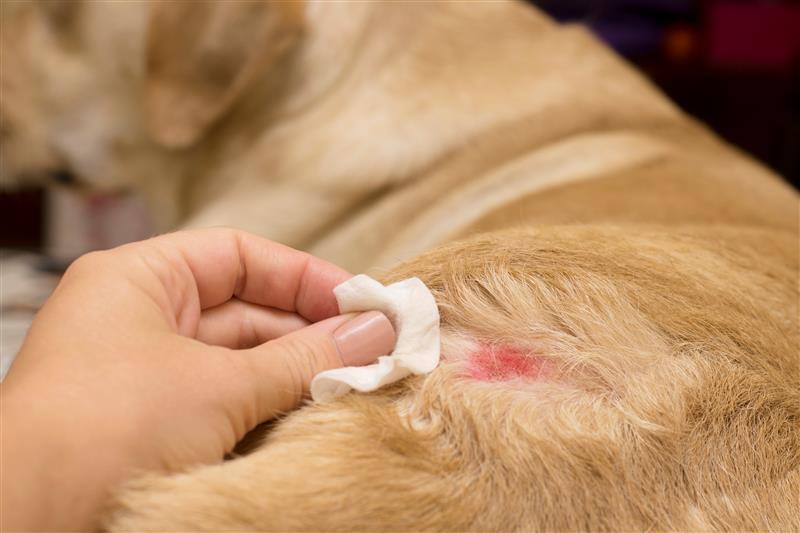They scritch and they scratch, but the itch doesn’t seem to go away! Pruritus, the medical term for itching, is one of the most common reasons for dog parents to bring their furry friend to the veterinarian. Pruritus can indicate several medical conditions, ranging from flea allergy dermatitis, seasonal allergies, food allergies, contact dermatitis, sarcoptic mange, and more. Moreover, pruritus has a multifactorial etiology that can be further complicated by secondary bacterial infections caused by excessive itching and inflammation.
Treatment for chronic itching can be frustrating, and while it may be tempting to find an at-home remedy for your dog, it is particularly important to visit a veterinarian in order to understand the underlying cause of your dog’s itching. While some studies have explored the efficacy of natural remedies for pruritus, research is overwhelmingly scarce. Moreover, without the guidance of a veterinarian, you may inadvertently expose your pet to natural treatments that do more harm than good!
What Causes Pruritus in Dogs?

The most common cause of pruritic allergic skin disease in dogs is canine atopic dermatitis (cAD). Approximately 10% of dogs in developed countries suffer from this condition in their lifetime, with the most notable allergens in cAD thought to be house dust mites, storage mites, pollen, and mold spores. Keeping this in mind, cAD is often seasonal, with occurrence and severity caused by an interplay of genetic and environmental factors. Breeds most likely to develop cAD include Labrador and Golden Retrievers, English Springer Spaniels, Hungarian Vizslas, Basset hounds, Rhodesian Ridgebacks, Boxers, Chinese Shar-Pei, West Highland White Terriers, Bull Terriers, French Bulldogs, Bichon Frises, and Tibetan Terriers. Parasitic dermatitis may occur as a result of the bite, infestation, or saliva of mites, fleas, ticks, or lice. It is important to note that chronic, year-round presentations of pruritus may suggest an environmental allergy and/or food allergy.
For any dog parent, identifying symptoms of pruritus is useful and can help your veterinarian identify the cause of your dog’s itching. Symptoms include:
- Severe itching
- Skin redness
- Hair loss
- Pimples or bumps
- Excessive licking
Harmful Effects of Avoiding Medical Treatment For Your Dog
When considering integrating herbal remedies into your dog’s care, it is important to note that both herbalists and scientists understand the scarcity in research regarding treatment efficacy. In fact, certain herbs actually induce adverse effects that may harm your dog and/or cause a possible infection to proliferate.
For example, a concerned pet owner may google scholarly articles and happen upon a recently published review looking at the use of essential oils in veterinary medicine to combat bacterial and fungal infections. In this review, the authors note the antibacterial benefits of cinnamon essential oils in fighting E. coli, Salmonella enterica, and P. aeriginosa, all while inhibiting biofilm formation. On paper this sounds promising, except that further research would clarify that in dogs, cinnamon causes peripheral vasodilation, can affect blood pressure, and is an irritant.
Beyond accidentally giving your dog a natural remedy they may be allergic to, reluctance to simply visit a veterinarian causes a delay in care and may exacerbate your dog’s condition. For example, failure to treat the root cause of your dog’s pruritus may result in a condition known as superficial pyoderma, which is a bacterial infection in the upper layers of the skin and hair follicle. These infections are often triggered by an overgrowth of normal dermal flora including most commonly by Staphylococcus pseudintermedius, along with Micrococcus sp., Bacillus sp., Corynebacterium sp., Escherichia coli, Proteus mirabilis, and Pseudomonas sp. Infection severity ranges widely, from simple infections to complex infections, and from surface to superficial or deep infections.
It is worth noting that visiting a veterinarian before your dog’s condition progresses to a condition like superficial pyoderma may end up being more cost-effective. Progression of a pruritic skin condition to severely pruritic pyoderma infection is also painful for your dog, and so consultation with a veterinarian is recommended.
What are Potential Natural Remedies for My Dog?
After consulting with your veterinarian, natural remedies in conjunction with your dog’s recommended treatment may prove to be beneficial.
Apple cider vinegar (ACV) in particular is a popular natural alternative for all-purpose cleaners, denture cleaners, and even itch remedies! Some studies suggest that ACV is not effective in treating parasitic infections, although these studies were assessing humans and not dogs. The intrinsic antimicrobial properties of apple cider vinegar have been observed in several studies. A (2018) investigation into the antimicrobial capacity of apple cider vinegar found that the minimum dilution of ACV recommended for growth inhibition of C. albicans, E. coli, and S. aureus is a 50/50 ratio of ACV and water. A spray is particularly useful for itchy skin, but this solution should only be used if there are no open wounds as the apple cider vinegar could cause stinging.
Studies have also suggested that alterations in your dog’s diet can help improve your dog’s condition and protect against pruritus. Polyphenols, which are naturally found in fruits and vegetables, have anti-neoplastic (helps prevent tumor formation) and anti-inflammatory properties. Polyphenols have also been found to decrease allergic immune responses through allergen sensitization and allergen re-exposure. Moreover, certain polyphenols have been found to interfere with antigen-presenting dendritic function/maturation and render antigen proteins hypoallergenic. While research on the impact diet has on canine allergies is limited, one uncontrolled clinical trial found improvements in atopic dermatitis when dogs were fed diets high in polyphenols, antioxidants, and polyunsaturated fatty acids.
Lastly, a (2019) review based on four books and a survey among veterinarians specialized in phytotherapy found that Calendula officinalis L. (Marigold), Hypericum perforatum L. agg. (St. John’s Wort), Matricaria chamomilla L./ Matricaria recutita L. (Chamomile), and Salvia officinalis L. (Sage) have broad-spectrum antibacterial and antifungal effects [11]. Regardless, if you are considering integrating herbal medicine into your dog’s care, consult your veterinarian to come up with a plan that can address the root cause of your furry friend’s pruritus most effectively.
Should I Go To The Veterinarian For My Dog’s Itching?
Yes. If you think your dog is suffering from itchy skin, please consult with a veterinarian as soon as possible. As has been previously mentioned, the potentially multifaceted nature of your dog’s itchy skin results in a complex diagnostics/treatment process that is only further complicated by delaying care. Consequently, having a solid understanding of the potential bacterial presentations in your pup is crucial.
Increasing contemporary evidence has begun to acknowledge the shortcomings of culture-based diagnostic testing, as the “microbiome is much more complex than has been identified with previous culture-based studies”. Several studies have revealed unculturable bacteria have been underestimated, while bacteria with high proliferation rates are possibly overestimated. Recent advances in next-generation sequencing (NGS) technologies allow metagenomics analysis and have provided exciting and practical opportunities for dysbiotic skin interventions.
In one of the largest canine cohort studies to date, MiDOG NGS technology was used to analyze the bacterial and fungal microbiota in health and diseased state skin. This study found that important taxa enriched in disease-state skin included S. pseudintermedius, S. schleiferi, Bacteroides pyogenes, and Peptoniphilus grossensis. The potential of NGS-based methods for the accurate quantification and identification of bacterial and fungal populations in diagnosing canine skin infections is remarkable and highlights the limitations of traditional culture-based testing.
Using MiDOG technology to perform a bacterial and fungal microbiome analysis of skin and ear samples of clinically affected and healthy dogs, the image above highlights higher microbial diversity in healthy state dogs than clinically affected dogs.
The MiDOG All-in-One Microbial Test utilizes the NGS technology as described in the study to detect and quantify all microbial DNA through untargeted and comprehensive sequencing and quantitative comparisons to reference databases. Considering shortcomings in culture-based diagnostics, the MiDOG NGS technology provides a useful opportunity to shed light on the microbial makeup of your dog’s skin microbiome for clinical application. The MiDOG microbiome test is a microbial identification test grounded on scientific research that provides veterinarians DNA evidence for the guided treatment of canine skin infections.
Categories: Dogs, Skin Health, Veterinary Dermatology

